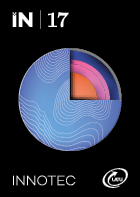Implementation of a methodology for the analysis of glyphosate in honey by LC-MS/MS, using QuPPe for sample preparation
DOI:
https://doi.org/10.26461/17.02Keywords:
Polar pesticides, Extraction with Methanol, Ion exchange liquid chromatography, Tandem mass spectrometryAbstract
Honey as a natural food has a high quality standard. Nevertheless, honey production is performed together with agricultural activities. Pesticide residues have been detected in honey samples from various countries including Uruguay, sometimes exceeding their maximum residue limits (MRL). The implementation of a modern methodology for the analysis of glyphosate in honey is presented. The sample preparation method named QuPPe, involves extraction with methanol and was specifically developed for the analysis of polar pesticides, by ionic liquid chromatography coupled to a mass spectrometer (LC–MS/MS). Due to the particularities of the glyphosate molecule it can not be included in a multiresidue method. The evaluated and validated methodology was developed by the European Union Reference Laboratory for Single Residue Methods (EURL–SRM). In order to perform its validation, SANTE guidelines were followed, obtaining good results even at the European MRL in honey (0.050 mg kg-1). Real Uruguayan samples were analyzed finding glyphosate residues in some cases. The methodology is useful for quality control and safety assurance of honey regarding glyphosate residues.
Downloads
References
Decourtye, A. y Pham-Delègue, M., 2002. Estimating the environmental impact of chemicals. Boca Ratón: CRC Press. pp.67-84.
Decourtye, A., Devillers, J., Genecque, E., Menach, K.L., Budzinski, H., Cluzeau, S. y Pham-Delègue, M.H., 2005. Comparative sublethal toxicity of nine pesticides on olfactory learning performances of the honeybee Apis mellifera En: Archives of Environmental Contamination and Toxicology, 48(2), pp.242-250.
Decourtye, A., Devillers, J., Aupinel, P., Brun, F., Bagnis, C., Fourrier, J. y Gauthier, M., 2011. Honeybee tracking with microchips: a new methodology to measure the effects of pesticides. En: Ecotoxicology, 20(2), pp.429-437.
DIEA, 2018. Anuario estadístico agropecuario. [En línea]. Montevideo: Ministerio de Ganadería, Agricultura y Pesca. [Consulta: 7 de noviembre de 2018]. Disponible en: https://descargas.mgap.gub.uy/DIEA/Anuarios/Anuario2018/Anuario_2018.pdf
Dirección General de la Granja, 2018. Boletín consumo de miel en Uruguay [En línea]. Montevideo: Ministerio de Ganadería, Agricultura y Pesca. [Consulta: 7 de noviembre de 2018]. Disponible en: http://www.mgap.gub.uy/sites/default/files/boletin_consumo_de_miel2018.pdf
El Hassani, A., Dacher, M., Gary, V., Lambin, M., Gauthier, M. y Armengaud, C., 2008. Effects of sublethal doses of acetamiprid and thiamethoxam on the behavior of the honeybee (Apis mellifera). En: Archives of Environmental Contamination and Toxicology, 54(4), pp.653-661.
European Commission. Directorate General for Health and Food Safety, 2017. Guidance document on analytical quality control and method validation procedures for pesticides residues analysis in food and feed. SANTE/11813/2017 [En línea]. [s.l.]: Unión Europea. [Consulta: 10 de octubre de 2018]. Disponible en: https://ec.europa.eu/food/sites/food/files/plant/docs/pesticides_mrl_guidelines_wrkdoc_2017-11813.pdf
Gill, J.P.K., Sethi, N. y Mohan, A., 2017. Analysis of the glyphosate herbicide in water, soil and food using derivatising agents. En: Environmental Chemistry Letters, 15(1), pp.85–100.
Smodiš Škerl, M., Kmecl, V. y Gregorc, A., 2010. Exposure to pesticides at sublethal level and their distribution within a honey bee (Apis mellifera) colony En: Bulletin of Environmental Contamination and Toxicology, 85(2), pp.125-128.
Unión Europea, 2013. Reglamento (UE) n ° 293/2013 de la Comisión, de 20 de marzo de 2013, que modifica los anexos II y III del Reglamento (CE) n ° 396/2005 del Parlamento Europeo y del Consejo por lo que respecta a los límites máximos de residuos de benzoato de emamectina, espinosad, espirotetramato, etofenprox, etoxazol, flutriafol, fosmet, glifosato y piraclostrobina, en determinados productos [En línea]. [s.l.]: Unión Europea. [Consulta: 10 de octubre de 2018]. Disponible en: https://publications.europa.eu/es/publication-detail/-/publication/dad2ca6b-9dcd-11e2-ab01-01aa75ed71a1
Published
How to Cite
Issue
Section
License
Los autores del manuscrito declaran conocer y aceptar los siguientes términos de responsabilidad:
Haber participado lo suficiente en el trabajo como para hacer pública la responsabilidad por su contenido.
Que el manuscrito representa un trabajo original que no fue publicado ni está siendo considerado por otra revista para su publicación, en parte o en forma íntegra, tanto impresa como electrónica.
Que en caso de ser solicitado, procurará o cooperará en la obtención y suministro de datos sobre los cuales el manuscrito esté basado.
Declara que la información divulgada que pudiera pertenecer a un tercero cuenta con la autorización correspondiente.
Autorización para la publicación y compromiso de cita de primera publicación
Los autores/as conservan los derechos de autor y ceden a la revista INNOTEC / INNOTEC Gestión el derecho de la primera publicación, con el trabajo registrado con la licencia de atribución Creative Commons Reconocimiento-NoComercial 4.0 Internacional. Creative Commons, que permite a terceros utilizar lo publicado siempre que mencionen la autoría del trabajo y a la primera publicación en esta revista sin fines comerciales.
El autor se compromete a realizar la cita completa de la edición institucional de esta primer publicación en las siguientes publicaciones -completas o parciales- efectuadas en cualquier otro medio de divulgación, impreso o electrónico.
Los autores/as pueden realizar otros acuerdos contractuales no comerciales independientes y adicionales para la distribución no exclusiva de la versión del artículo publicado en esta revista (p. ej., incluirlo en un repositorio institucional o publicarlo en un libro) siempre que indiquen claramente que el trabajo se publicó por primera vez en esta revista.
Se permite a los autores/as publicar su trabajo en Internet (por ejemplo en páginas institucionales o personales) antes y durante el proceso de revisión, ya que puede conducir a intercambios productivos y a una mayor y más rápida difusión del trabajo publicado (vea The Effect of Open Access). A su vez los autores/as autorizan al LATU a publicar el trabajo en su repositorio digital.
Los conceptos y opiniones vertidos en los artículos son de responsabilidad de sus autores.
Este obra está bajo una licencia Reconocimiento-NoComercial 4.0 Internacional.












